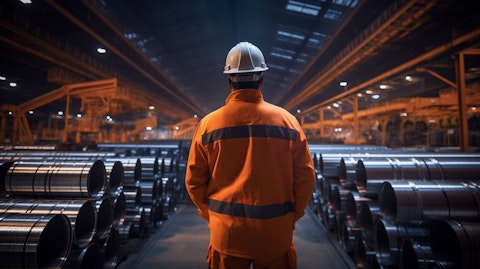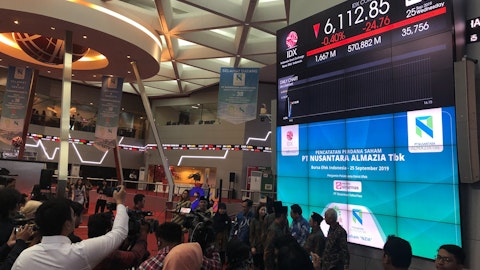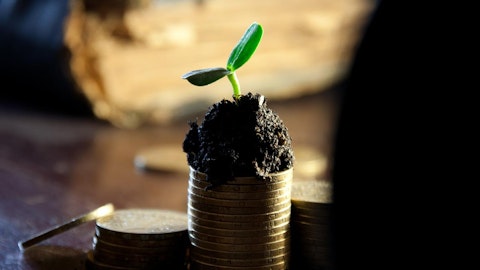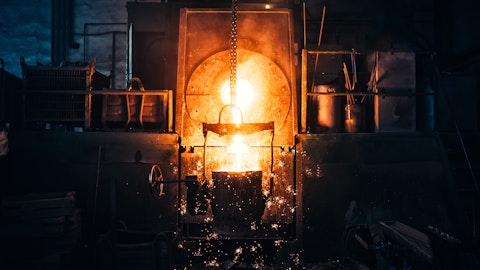Gerdau S.A. (NYSE:GGB) Q3 2023 Earnings Call Transcript November 7, 2023
Renata Oliva Battiferro: Good afternoon, everyone, and welcome to Investor Relations and our Presentation for the Third Quarter of 2023. My name is Renata, Head of Investor Relations. And participating in our video conference today are the CEO of Gerdau, Gustavo Werneck; and the CFO, Rafael Japur. We would like to inform you that this video conference is being recorded and will be available on the company’s IR website, ir.gerdau.com, where the complete material of the earnings release is available. You can also download the presentation using the chat icon. We would like to remind you that the broadcast of this video conference is being done with simultaneous translation through the tool available in the platform. To access the feature, just click on the interpretation button via the globe icon at the bottom of the screen and choose your preferred language, Portuguese or English.
For those of you listening to the video conference in English, there is an option to mute your original audio in Portuguese by clicking on mute original audio. During the company’s presentation, all participants will have their microphones disabled. Following the presentation, we will begin the Q&A session. Analysts and investors can send their questions in advance via chat and can open their camera if they prefer during the Q&A session. We wish to emphasize that the information contained in this presentation and any other statements that may be made during the video conference concerning Gerdau’s business prospects, projections, and operating and financial goals are based on the beliefs and assumptions of the company’s management as well as information currently available.

Forward-looking statements are not guarantees of performance. They involve risks, uncertainties, and assumptions because they relate to future events and, therefore, depend on circumstances that may or may not occur. Investors should understand that general economic conditions, market conditions, and other operating factors may differ substantially from those expressed in such forward-looking statements. I would now turn the floor to Gustavo Werneck to initiate the presentation. Please, sir, you may proceed.
Gustavo Werneck: Hello, everyone. I hope you are well and thank you very much for the opportunity to meet again during our video conference to announce Gerdau’s results for the third quarter of 2023. I am joined by our CFO, Rafael Japur, and it’s always a pleasure for both of us to talk to you about our performance and also to clarify any points that may arise during our presentation. I will start by talking about the macro business environment, the highlights of the overall results, and then I will detail the performance of our business operations in the quarter. Next, Japur will then share some information about our financial performance. And finally, I will highlight a few points from our ESG agenda. We will make a shorter initial presentation so that at the end, we will have more time to talk to you about the points that you want to elaborate in more detail.
On the second slide, I would like to point out that we ended the first nine months of the year with an accident frequency rate of 0.69. This result is below the rate of 0.76 recorded in the consolidated figures for 2022, which represents the lowest rate ever recorded in our annual historical series. This performance renews our commitment to the health and safety of all of our people. At Gerdau, safety always comes first, since no result is more important than people’s lives. Moving on to the next two slides, I would like to point out that the macro environment in which Gerdau operates impacted our shipments of steel in the third quarter. Issues like global inflation, high interest rates, military conflicts, and weaknesses in the Chinese domestic economy contributed significantly to the slowdown in the level of activity in the markets where we operate.
See also 15 Biggest Tea Producing Countries In The World and Where Should You Invest $1000 Right Now?.
Q&A Session
Follow Gerdau S A (NYSE:GGB)
Follow Gerdau S A (NYSE:GGB)
In turn, the Brazilian market was strongly affected by an excessive influx of imported steel mainly from China, a movement that continues to occur in this fourth quarter and which requires urgent corrective measures on the part of the federal government, which I will elaborate further on. Moving on to Slide 5, I will talk about the highlights of each of our business operations and the outlook for the coming months. For the North American market, after the strong growth recorded in the first few months of the year, we can already see a slowdown in demand, which is still at healthy levels, also due to the seasonality of the fourth quarter and aim at an increase in imports, high interest rates, and the inflationary context. Our order book in the U.S. remains stable at a high level of 60 days, and we continue to work on initiatives focused on cost control and operating efficiency, which allows us to maintain our profitability levels above the other local players.
We are optimistic about the long-term scenario since the recent measures taken by the U.S. Government, such as the Inflation Reduction Act (IRA) and the reshoring movement will still have a positive effect on the market in the coming periods, as well as investments linked to infrastructure package. I emphasize that the North America BD is well positioned with its product portfolio and also prepared to continue meeting the future needs of our customers and sharing value with local stakeholders. Now moving to the next slide, I will now talk about our special steel business operation. The automotive market in the U.S. continues to perform well, with the production of light and heavy vehicles reaching 15,332,000 units respectively, still below historical levels.
In addition, the oil and gas segment remains resilient, with rig counts stable when compared to the previous period. In turn, the outlook for the special steel market in Brazil continues to be influenced by uncertainties linked to access to credit lines and high interest rates, which contribute to restricting demand for vehicles. The National Association of Vehicles Manufacturers, ANFAVEA, has even revised downwards its projections for the sector this year. Light vehicle production is expected to grow by only 3.2%, while heavy vehicle production is expected to fall by 34.2%, the latter also impacted by the changing truck technology to Euro 6. Production of agricultural machinery is also forecast to fall by 16% year-on-year in 2023. Despite the production of a record harvest and the increase in resources via the harvest plan, the late introduction of the plan and the devaluation of commodities on the international market have had a negative impact on the sector’s performance.
Moving on to the next slide, I will now talk about the long and flat steel scenario in Brazil, whose performance in the third quarter reflects a slowdown in demand for steel, but mainly the excessive influx of imports into the country, which has negatively affected the sector. Between January and September, steel imports grew by 57.9% compared to the same period in 2022, totaling 3.7 million tonnes. In September, the penetration rate in Brazil reached 23%, according to the Brazil Steel Institute. For 2023 as a whole, the Brazilian steel market is expected to post an all-time record volume of around 5 million tonnes, with products from countries like China, Russia, South Korea and Turkey. I would remind you that the largest volume of imports ever recorded in the country was in 2010 with 4.4 million tonnes, at a time when Brazil’s GDP was growing by around 7%.
I would point out that if we take into account also indirect steel imports, the volume of imported materials entering Brazil is equivalent to the capacity of two large integrated mills. Competition with Asian steel is unfair under normal market practices, since the prices charged are lower than production costs. With this backdrop, since half of this volume of imported product comes from China, which exports with unfair and predatory trade practices, it is urgent for the federal government to temporarily raise import tariffs to 25% in the short term, in order to ensure the sustainability and competitiveness of the national steel sector, similar to moves already made in regions like Europe, the United States and Mexico. The steel sector in Brazil employs three million people, including direct, indirect and ancillary jobs and the significant portion of these jobs are at an imminent risk in the face of this challenging short-term scenario.
If prolonged, the situation will also accelerate the deindustrialization of the country, which is already underway, and threatens the investments planned by the steel sector for the coming years. Now let’s move to the next slide, where I start speaking about Argentina, where steel demand remains stable in the third quarter, driven by the construction, mining and energy sectors. Inflationary pressure, restrictions on imports and the presidential elections remain points of attention for the performance of the local market in the coming quarters. Uruguay’s scenario remains positive, reflecting good levels of steel consumption, particularly in the agribusiness sector, and also due to public and private investments. In Peru, El Niño weather issues continue to have an impact on the domestic market, particularly in the construction sector.
I will now hand over to Japur, and then I will be back to talk about our ESG journey and to answer your questions.
Rafael Japur: Thank you, Gustavo. Hello, everyone. It’s always a great pleasure to be here with you once again for our results presentation. Starting with Slide 11, we have some of the financial highlights of the period, showing that the slowdown in global demand and the excessive penetration of imported steel in Brazil will let the company to report lower results when compared to those posted in previous quarters. But still very robust results when we look at our historical numbers and our 122 years of history. If we were to conclude the year of 2023 today with nine months to date, these nine months alone would be equivalent to the third best year in the company’s year. This shows how strong our results are both today and also in terms of our historical numbers.
Moving now to Slide 12, I will talk about our cash flow and the company’s working capital. We ended the quarter with working capital of R$15.8 billion, 4% lower than the previous quarter due to lower inventory levels. I would like to mention that this is now the fourth consecutive quarter of reduction in our inventory levels. Our cash conversion cycle still remains high due to a decline in net sales during this past period. Therefore, we believe that there is room for further release of working capital in the coming quarters. Now, moving on to the right hand side of the slide, we will talk about our cash flow. Gerdau generated this quarter R$2.246 billion of free cash flow in the quarter, our adjusted EBITDA stood at R$3.349 billion with a margin of approximately 20%.
We had a working capital release of R$501 million, which compensated for the slightly lower result when compared to the second quarter. We invested R$1.486 billion in CapEx in line with our guidance of R$5 billion for 2023. In the next slide, we will talk about our liquidity and debt. We continue to have an excellent level of leverage with a net debt over EBITDA ratio of 0.34x. We ended September with gross debt of R$11.478 billion below our limit of R$12 billion set by our policy, despite a U.S. dollar rate 4% higher than in the previous quarter. On the right hand side of the page, we show a breakdown of our liquidity and our debt amortization schedule. Considering the cash position of R$6 billion added to our revolver line of US$875 million, equivalent to approximately R$4.5 million, which is fully available and absolutely undrawn, this adds up to more than R$10 billion of liquidity available for the company.
We strongly believe that the maintenance of a deleveraged balance sheet with maturity dates well distributed over time is critical to allow us to make the investments required to develop and enhance our operations, even in more challenging times, which are so common in an industry that is cyclical and capital intensive. Moving on to Slide 14, let’s talk about return to our shareholders. As you can see in the chart on the left, our dividend payout remains above the targeted minimum of 30% set by our policy, even in the midst of a more challenging scenario, reaching a payout of 58% for Gerdau in the quarter. Last week, we concluded the company’s buyback program. We performed a significant share of the program, buying 45 million preferred shares of Gerdau S.A. and 48 million preferred shares of Metalurgica Gerdau.
Both Gerdau and Metalurgica Gerdau will assess the potential for new share buyback programs in a timely manner. Lastly, thanks to the results delivered and our cash position and liquidity this quarter, the company decided to pay dividends, both at Gerdau S.A. and Metalurgica. Dividends will be paid on December 13 and 14, respectively. Gerdau S.A. will pay R$0.47 per share, equivalent to a total of approximately R$822 million whereas Metalurgica Gerdau will pay R$0.93 per share, totaling R$960 million. Both cases will take into account the position of the shares held on November 17, 2023. Finally, on Slide 15, we give you an update on our progress in the company’s strategic CapEx. Of the R$11.900 billion to be invested between 2021 and 2026, approximately one-third has already been disbursed by third quarter 2023.



